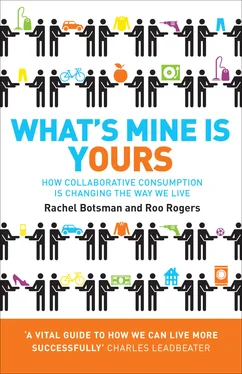Remarkably, out of the ten thousand completed trips to date there have been no reports of theft. Sometimes an apartment is not clean or someone does not show up, but these cases are rare. Chesky believes that a ‘trusted intermediary’ and secure payment system have a lot to do with this record. When making a booking, guests put the reservation on hold using a credit card or PayPal account. Hosts are not paid in full until twenty-four hours after a guest has checked in. Airbnb charges hosts a standard 3 percent service fee and travellers an additional 6 to 12 percent depending on the reservation price. Aside from turning Airbnb into a real business with a profitable revenue model that has been growing at more than 10 percent every month since they launched, the founders believe that some form of payment ‘puts both parties on the best behaviour and makes the whole process more reliable.’
When Chesky told his grandfather about the idea behind Airbnb, ‘It seemed totally normal to him. My parents had a different reaction. I could not figure out why at first.’ Chesky later realized that his parents grew up in the hotel generation, whereas his grandfather and his friends would stay on farms and in little houses during their travels. Airbnb is not very different from that experience. ‘We are not the modern invention, hotels are.’ Indeed, prior to the 1950s, staying with friends or friends of friends was a common way to travel. Airbnb is an old idea, being replicated and made relevant again through peer-to-peer networks and new technologies.
There is now an unbounded marketplace for efficient peer-to-peer exchanges between producer and consumer, seller and buyer, lender and borrower, and neighbour and neighbour. Online exchanges mimic the close ties once formed through face-to-face exchanges in villages, but on a much larger and unconfined scale. In other words, technology is reinventing old forms of trust. Chesky predicts, ‘The status quo is being replaced by a movement. Peer-to-peer is going to become the default way people exchange things, whether it is space, stuff, skills or services.’
The Rise of Collaboration
Over the past couple of years, we started to notice that stories and business examples like Airbnb weren’t unusual. At dinner parties, instead of bragging about their new Prius, friends boasted how they had given up their cars altogether by becoming ‘Zipsters’ (members of the car-sharing service Zipcar). More and more friends were selling stuff on craigslist and eBay; swapping books, DVDs and games on sites such as Swap and OurSwaps; and giving unwanted items away on Freecycle and ReUseIt. On a trip to Paris, we saw cyclists pedalling around on sleek-looking bikes with the word ‘Vélib’ (Paris’s bike-sharing scheme) on their crossbars. A friend in London told us about her new favourite Channel 4 programme called Land-share . And we kept hearing about the number of people joining Community Supported Agriculture (CSA) programmes or local co-ops. We saw stats and stories about online cooperation and the growth in virtual communities. Every day there are more than 3 million Flickr images uploaded; 700,000 new members joining Facebook; 50 million ‘Tweets’; and 900,000 blogs posted. There are twenty-three hours of YouTube videos uploaded every minute, the equivalent of Hollywood releasing more than 90,000 new full-length films into theatres each week. [1] Statistics on online networks taken from ‘A Day on the Internet’, www.onlineeducation.net/internet.
‘Collaboration’ had become the buzzword of the day with economists, philosophers, business analysts, trend spotters, marketers and entrepreneurs – and appropriately so.
We stumbled on articles about sharing, bartering, lending or swapping, often with some kind of ‘co’ in the headlines, such as ‘Co-Housing for Gen X & Y’, ‘Co-working: Solo but Not Alone’, ‘Couch Surfing: This Isn’t Just About a Place to Crash’, ‘Can Community Co-Ops Revive Our Towns?’ ‘Social Networking for Communes’, ‘Global Collectivist Society Is Coming Online,’ ‘Living Together: Modern Answer to the Commune’, and ‘Governing the Commons’. Even science, social psychology and economic journals brimmed with popular articles about the self-organizing behaviours of ants, the ‘intelligence’ of swarming honeybees, and the cooperation of schools of fish and flocks of birds.
The more we examined these trends, the more convinced we were that all of these behaviours, personal stories, social theories and business examples pointed to an emerging socioeconomic groundswell; the old stigmatized C’s associated with coming together and ‘sharing’ – cooperatives, collectives, and communes – are being refreshed and reinvented into appealing and valuable forms of collaboration and community. We call this groundswell Collaborative Consumption.
The collaboration at the heart of Collaborative Consumption may be local and face-to-face, or it may use the Internet to connect, combine, form groups, and find something or someone to create ‘many to many’ peer-to-peer interactions. Simply put, people are sharing again with their community – be it an office, a neighbourhood, an apartment building, a school or a Facebook network. But the sharing and collaboration are happening in ways and at a scale never before possible, creating a culture and economy of what’s mine is yours.
Every day people are using Collaborative Consumption – traditional sharing, bartering, lending, trading, renting, gifting and swapping, redefined through technology and peer communities. Collaborative Consumption is enabling people to realize the enormous benefits of access to products and services over ownership, and at the same time save money, space and time; make new friends; and become active citizens once again. Social networks, smart grids and real-time technologies are also making it possible to leapfrog over outdated modes of hyper-consumption and create innovative systems based on shared usage such as bike or car sharing. These systems provide significant environmental benefits by increasing use efficiency, reducing waste, encouraging the development of better products, and mopping up the surplus created by over-production and – consumption.
In this book, we have organized the thousands of examples of Collaborative Consumption from around the world into three systems – product service systems, redistribution marketsand collaborative lifestyles. Together these systems are reinventing not just what we consume but how we consume.
Although the examples of Collaborative Consumption range enormously in scale, maturity and purpose, they share similar underlying principles essential to making them work that we explore throughout this book – critical mass, idling capacity, belief in the commonsand trust between strangers.
Collaborative Consumption is not a niche trend, and it’s not a reactionary blip to the 2008 global financial crisis. It’s a growing movement with millions of people participating from all corners of the world. Many of these participants may not even realize that they are part of this groundswell. To illustrate the explosive rise of Collaborative Consumption, let’s first look at the growth stats behind a few mainstream examples: Bike sharing is the fastest-growing form of transportation in the world, [2] Abha Bhattarai, ‘Bike-Sharing: Cycling to a City Near You’, Fast Company (26 June 2009), www.fastcompany.com/blog/abha-bhattarai/abha-bhattarai/bike-sharing-cycling-city-near-you.
with over 500,000 trips being made in the first six weeks of operation for London’s Barclays Cycle Hire. Zilok, a leader in the peer-to-peer rental market, has grown at a rate of around 25 percent since it was founded in October 2007. [3] Statistics on Zilok taken from Reuters release, ‘Rent Your Way Out of the Credit Crunch Online’ (5 December 2008), http://www.reuters. com/article/idUSTRE4B44DE20081205.
Two billion dollars worth of goods and services were exchanged through Bartercard, the world’s largest business-to-business bartering network in 2009, up by 20 percent from 2008. [4] Statistics on bartering taken from William Lee Adams, ‘Bartering: Have Hotel, Need Haircut’, Time (2 November 2009), http://www.time.com/time/magazine/article/0,9171,1931665,00.html.
UK-founded Zopa, the first online peer-to-peer lending marketplace in the world, did more business in its fifth year, at £35.5 million (March 2009 to March 2010), than in the previous four years combined at £34.5 million. By October 2010, Zopa members had lent over £100 million between each other. Freecycle, a worldwide online registry that circulates free items for reuse or recycling, has more than 5.7 million members across more than eighty-five countries. More than twelve thousand items are ‘gifted’ every day through the network. [5] Statistics on Freecyle taken from Freecycle press release, ‘Largest Environmental Web Community in the World’ (9 September 2008), www.freecycle.org/pressreleases/08-09-09_Freecycle_press_release. pdf?.
U-Exchange, one of the most successful of all swap sites, saw a 70 percent increase in new members in 2008, and the membership of the trading site Swap grew tenfold in 2009 over the previous year. On thredUP, a clothing exchange for children’s clothes, approximately twelve thousand items were exchanged within the first eight days of launching in April 2010. Landshare, a site that connects gardenless would-be growers with unused spare land, has more than 55,000 members across the UK today. CouchSurfing, a global website that connects travellers with locals in more than 235 countries and territories, is currently the most visited ‘hospitality service’ on the Internet. [6] Statistics on CouchSurfing: http://traffic.alexa.com/graph?w=900&h =500&r=3m&y=p&u=CouchSurfing.org/&u=hospitalityclub. org&u=globalfreeloaders.com&u=place2stay.net&u=servas.org and www.CouchSurfing.org/statistics.html.
In the United States, there are more than 2,50 °CSA schemes – where people pay a sum of money at the beginning of the year to a local farmer who will deliver a weekly box of fresh produce throughout the growing season – compared with only 1 in 1985. In the UK, there are more than 100,000 people on the waiting list for an allotment (a plot of land that can be rented by an individual for growing fruits and vegetables) and in some parts of London the wait is up to forty years. [7] Statistics on allotment waiting lists were widely reported in the British media in August 2009, such as ‘Forty-Year Wait for Allotments’, BBC coverage: http://news.bbc.co.uk/2/hi/uk_news/england/london/8193100.stm.
In the midst of the global financial crisis, when the federal government was bailing out the ‘Big Three’ car companies, car-sharing membership increased by 51.5 percent in the United States. [8] Joseph Pisani, ‘Car Sharing Takes Off’, CNBC (4 December 2009), http://76.12.4.249/artman2/uploads/1/Car_Sharing_Takes_Off_-_ CNBC.pdf.
By 2015, it is estimated that 4.4 million people in North America and 5.5 million in Europe will belong to services like the one from Zipcar, whose membership alone more than tripled in 2009. [9] David Zhao, ‘Carsharing: A Sustainable and Innovative Personal Transport Solution’, Frost & Sullivan Automotive Practice (28 January 2010), www.frost.com/prod/servlet/market-insight-top. pag?Src=RSS&docid=190795176.
UK-based WhipCar, the first neighbour-to-neighbour car-sharing service had over 1,000 owners accepting bookings within the first six months of launch. We could go on. Collaborative Consumption is a snowball idea, one with enough heft to keep gathering momentum and enough adhesion to keep growing bigger.
Читать дальше












